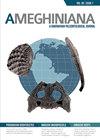阿根廷下中新世巴塔哥尼亚盖曼组新生代第一分离腕足动物(腕足目:扁足目)
IF 1.5
4区 地球科学
Q3 PALEONTOLOGY
引用次数: 0
摘要
摘要。Discinids是一组不发音的腕足动物,有有机磷壳,化石记录非常差。我们首次报告了这个家族在巴塔哥尼亚新生代的存在,以两个新物种为代表:Discinisca Porvinir sp.11.和Discinisca Messii sp.11.,均在阿根廷丘布特省Gaiman组(下中新世)的海洋沉积物中发现。标本来自四个地点:布林·格温、美洲狮峡谷、埃斯库迪达岛和蓬塔·洛马。第一个物种D.Porviner sp.Nov.展示了一个壳,其背部轮廓为亚圆形至亚圆形,最大宽度位于稍早的位置,顶部接近总阀门长度的最后四分之一,外部雕塑由边缘不规则的窄同心带组成。相比之下,第二个物种D.Messii sp.Nov.展示了一个阀门,其背部轮廓呈亚圆形至圆形,顶部位于后边缘附近,外部雕塑由同心带组成,横截面呈圆形三角形轮廓。新物种似乎与D.Lamellosa和D.Laevis的生活有关,这两个物种都分布在南美西部。盖曼组包括磷酸盐结节和大量保存完好的磷酸盐脊椎动物遗骸。因此,以及为脊椎动物推断的生物间质条件,有利于保护腕足动物。总结。门徒是一组不发音的腕足动物,有有机磷阀,化石记录非常差。在这项工作中,我们首次报告了这个家族在巴塔哥尼亚新生代的存在,以两个新物种为代表:Discinisca Porvinir sp.nov.和Discinisca Messii sp.nov.,均在阿根廷丘布特省盖曼组(下中新世)的海洋沉积物中发现。标本来自四个地方:布林·格温、美洲狮峡谷、埃斯库迪达岛和蓬塔·洛马。第一个物种D.Porvinir sp.Nov.在背部有一个从亚圆形到亚圆形的轮廓,最大宽度略高于前面,顶部接近总长的最后四分之一,外部装饰由边缘不规则的窄同心带提供。另一方面,第二个物种D.Messii sp.Nov.显示了一个阀门,背部有亚圆形至圆形的轮廓,顶部靠近后缘,外部装饰由横截面呈圆形三角形的同心条带提供。新物种似乎分别与活着的分类群D.Lamellosa和D.Laevis有关,这两个分类群都分布在南美洲西部。盖曼地层包括磷酸盐结节和保存完好的磷酸盐脊椎动物遗骸的丰富案例。因此,以及从脊椎动物中推断出的生物地层条件,有利于腕足类的保护。本文章由计算机程序翻译,如有差异,请以英文原文为准。
First Discinid Brachiopods (Brachiopoda: Lingulida) from the Cenozoic of Patagonia (Gaiman Formation, Lower Miocene, Argentina)
Abstract. Discinids are a group of inarticulate brachiopods with organophosphatic shells and a very poor fossil record. We report for the first time the presence of this family in the Cenozoic of Patagonia, represented by two new species: Discinisca porvenir sp. nov. and Discinisca messii sp. nov., both found in marine deposits of the Gaiman Formation (Lower Miocene) in Chubut province, Argentina. Specimens come from four localities: Bryn Gwyn, Cañadón del Puma, Isla Escondida, and Punta Loma. The first species, D. porvenir sp. nov., presents a shell with subcircular to subtrapezoidal outline in dorsal view and maximum width located slightly anterior, apex near to the last quarter of the total valve length, and external sculpture formed by narrow concentric bands with irregular edges. In contrast, the second species, D. messii sp. nov., shows a valve with subcircular to circular outline in dorsal view with apex placed near to posterior margin, and external sculpture formed by concentric bands with a rounded triangular profile in transverse section. The new species seem to be related to the living D. lamellosa and D. laevis, respectively, both with a western South American distribution. The Gaiman Formation includes phosphatic nodules and abundant cases of well-preserved phosphatic vertebrate remains. Due to this, and the biostratinomic conditions deduced for vertebrates, the preservation of the brachiopods could be favoured. Resumen. Los discinidos son un grupo de braquiópodos inarticulados con valvas organofosfáticas y un registro fósil muy pobre. En este trabajo reportamos por primera vez la presencia de esta familia en el Cenozoico de Patagonia, representada por dos especies nuevas: Discinisca porvenir sp. nov. y Discinisca messii sp. nov., ambas encontradas en depósitos marinos de la Formación Gaiman (Mioceno Inferior) en la provincia del Chubut, Argentina. Los especímenes provienen de cuatro localidades: Bryn Gwyn, Cañadón del Puma, Isla Escondida y Punta Loma. La primera especie, D. porvenir sp. nov., presenta una valva con contorno subcircular a subtrapezoidal en vista dorsal, con el ancho máximo situado levemente anterior, y el ápice cerca del último cuarto del largo total, y ornamentación externa dada por bandas concéntricas angostas con bordes irregulares. Por otro lado, la segunda especie, D. messii sp. nov., muestra una valva con contorno subcircular a circular en vista dorsal con el ápice cerca del margen posterior, y ornamentación externa dada por bandas concéntricas con perfil triangular redondeado en sección transversal. Las nuevas especies parecieran estar relacionadas con los taxones vivientes D. lamellosa y D. laevis, respectivamente, ambos con distribución en el oeste de América del Sur. La Formación Gaiman incluye nódulos fosfáticos y casos abundantes de restos de vertebrados fosfáticos muy bien preservados. Debido a ello, y a las condiciones bioestratinómicas deducidas a partir de los vertebrados, la preservación de los braquiópodos se habría visto favorecida.
求助全文
通过发布文献求助,成功后即可免费获取论文全文。
去求助
来源期刊

Ameghiniana
地学-古生物学
CiteScore
2.50
自引率
10.00%
发文量
21
期刊介绍:
Ameghiniana is a bimonthly journal that publishes original contributions on all disciplines related to paleontology, with a special focus on the paleontology of Gondwana and the biotic history of the southern hemisphere. Published yearly since 1957, it has undoubtedly become the main palaeontological publication from Latin America. Ameghiniana has recently broadened its editorial board, reorganized its production process, and increased to a bimonthly frequency, which resulted in a significant decrease in the turn around time.
 求助内容:
求助内容: 应助结果提醒方式:
应助结果提醒方式:


